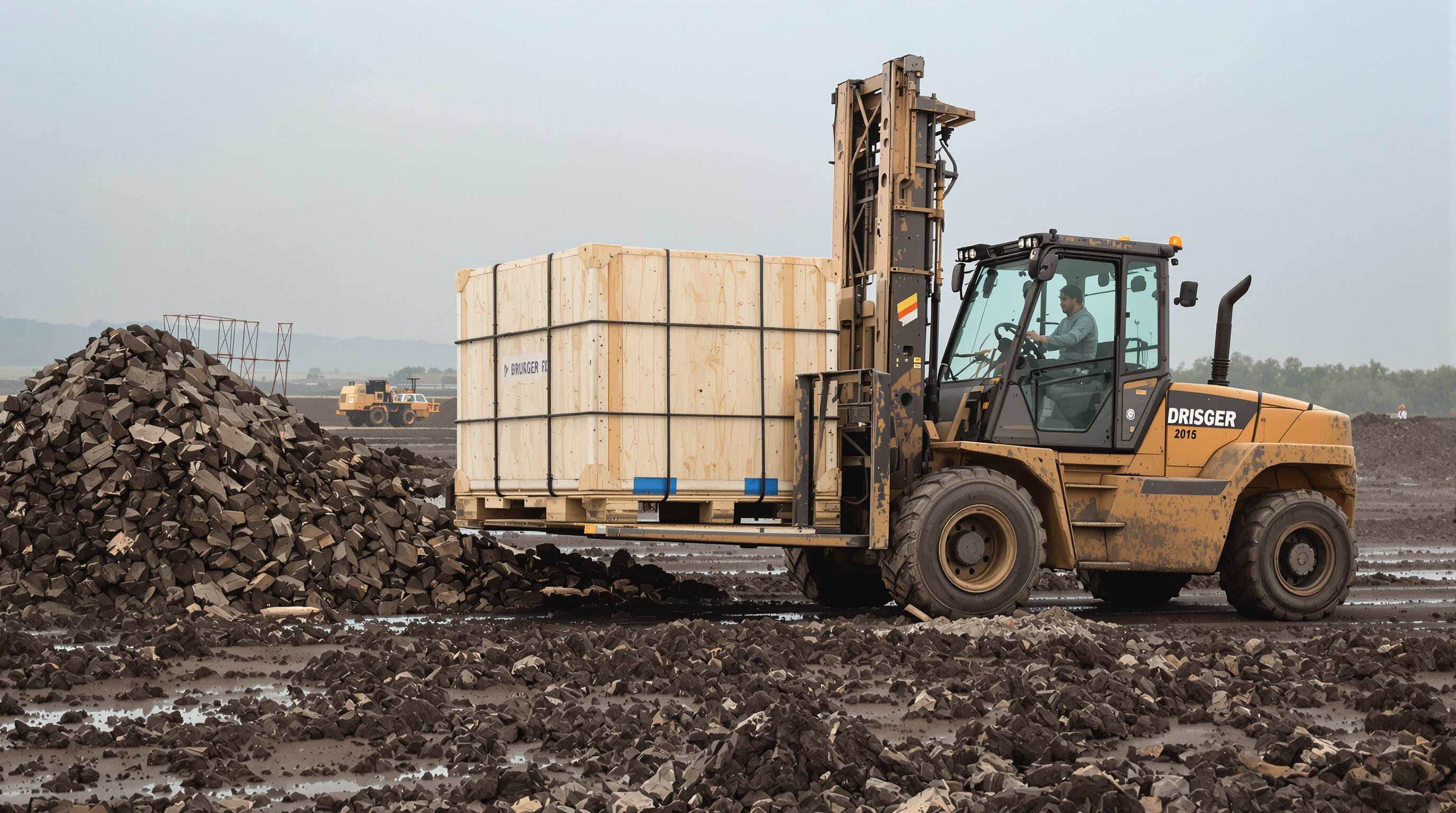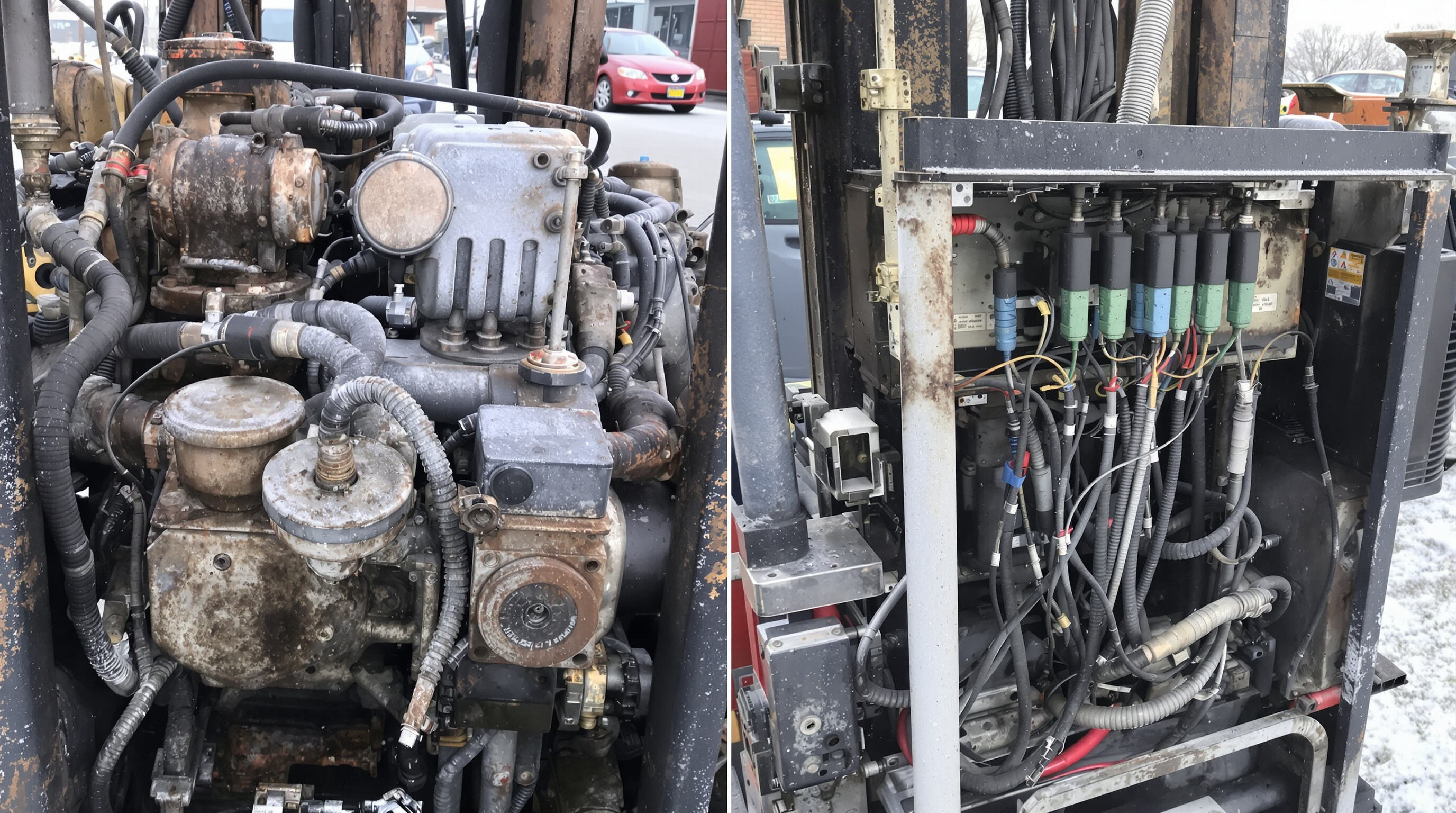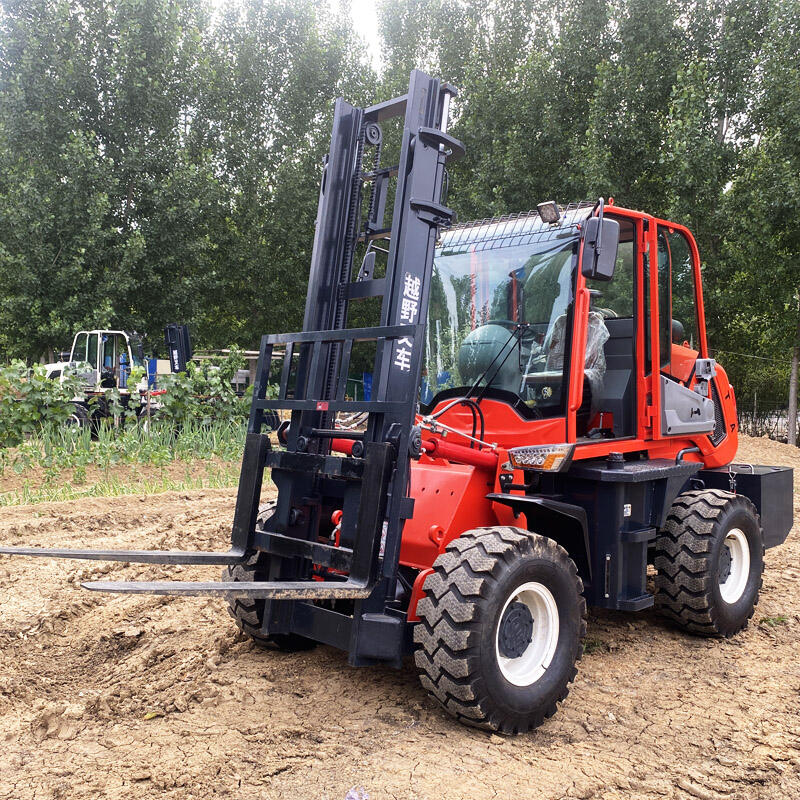All-Terrain Forklifts of Power, Torque, and Lifting Performance in Rugged Environments

Looking at AllTerrain forklifts, how power gets delivered makes all the difference in tough working conditions. Most diesel versions put out around 74 to 140 horsepower according to Hessne from 2023 research, which means they can keep going strong through muddy areas, gravel patches, and sloped surfaces where electric models often struggle. The extra muscle really matters when moving heavy stuff over rough terrain too. Think about those loads heavier than 8,000 pounds sitting on bumpy ground. Diesel engines just keep pushing along consistently even when the ground fights back, something many operators have noticed firsthand during long shifts.
Diesel vs. Electric Forklift Power Comparison in All-Terrain Conditions
When it comes to outdoor work, diesel engines still rule the roost because they're mechanically straightforward and don't care about voltage fluctuations. This matters a lot in cold weather conditions where temps fall below -10 degrees Celsius or when working on icy surfaces. Electric forklifts do fine on smooth concrete floors, but things get tricky when going uphill. According to Industrial Safety Journal from last year, these electric models lose between 18 to 22 percent of their power when tackling slopes steeper than 15 degrees. Take a standard 10,000 pound diesel forklift for example. It keeps about 95% of its power even on rough ground, while similar electric models only manage around 78%. That makes a real difference in actual operations where terrain isn't always perfect.
| Feature | Diesel Forklifts | Electric Forklifts |
|---|---|---|
| Optimal Temperature | -40°C to 50°C | -5°C to 40°C |
| Slope Performance | 25° max incline | 15° max incline |
| Power Consistency | ±5% variance | ±18% variance |
Torque Delivery and Acceleration: Diesel Engines vs. Electric Motors
The torque curve of diesel engines peaks between around 1,400 to 1,800 RPMs, giving them better grip when pushing heavy stuff through sticky clay or loose sand conditions. Electric motors do offer that immediate torque sensation, but once batteries drop below about half charge, power output typically plummets somewhere between 30 and 40 percent. This happens all the time during those long days out in the field. According to actual testing in real world situations, diesel powered machines can speed up nearly twice as fast carrying 8,000 pound loads uphill at ten degree angles. They finish lifting cycles roughly twelve minutes quicker compared to what we see from electric options doing the same work.
Lifting Capacity and Load Stability Under Variable Terrain Stress
Pneumatic tires and hydraulic dampers on diesel models mitigate the 20% lifting capacity reduction caused by ground instability (Industrial Safety Journal 2023). A 12,000-lb rated diesel forklift safely handles 9,600 lbs on severely uneven terrain, while electric equivalents require a 25% capacity buffer under similar conditions. Three key stability systems enhance AllTerrain performance:
- Counterweight positioning algorithms
- Dynamic load center adjustment
- Tire pressure monitoring systems
Operational Efficiency and Workflow Continuity
Refueling vs. Recharging Time: Impact on All-Terrain Forklift Uptime
Diesel-powered all-terrain forklifts require just 5–7 minutes to refuel, according to 2023 energy logistics studies, minimizing downtime. In contrast, electric models need 1.5–3 hour recharging cycles, which disrupt continuous operations—especially at remote construction sites. For 24/7 projects, this delay can reduce productive uptime by up to 18% compared to diesel units.
Battery Life and Range Limitations for Electric Models in Outdoor Use
Cold weather or rough terrain can cut the range of electric all-terrain forklifts by around 20 to 30 percent according to some battery testing done independently. When these machines have to keep speeding up while carrying heavy stuff, their batteries drain much faster. This means workers often need to swap out batteries halfway through their shifts, which really disrupts what they're trying to get done. Even though companies are starting to roll out those modular battery setups, real world numbers indicate that electric models outdoors still spend about 27% more time sitting idle dealing with power issues compared to traditional diesel forklifts.
Fuel Availability and Energy Efficiency Across Job Sites
Diesel is still widely available everywhere, and having fuel stored on site means operations can keep going even when there's no electricity grid nearby. Electric forklifts look great on paper with their 89% efficiency rating in lab conditions, but things get tricky out on actual construction sites where efficiency plummets to around 63-68%. The rough ground, hills, and all those extra systems running like lights and cooling pumps really eat into that efficiency. We're starting to see some hybrid options come onto the market, though they're still pretty rare stuff right now. These hybrids make up under 5% of what's sold for tough jobsites, which shows just how much the industry still relies on traditional diesel power despite all the talk about going green.
Durability and Long-Term Reliability in Harsh Conditions

Lifespan comparison: Diesel vs. electric drivetrains in extreme environments
Most diesel all terrain forklifts can run reliably for about 15 to 20 years if maintained properly. Their heavy duty construction includes those solid cast iron engine blocks and mechanical fuel systems that just don't break down easily even when exposed to harsh weather or dusty conditions. The situation looks different for electric models though. Recent studies from 2024 show something interesting - around one third of early electric forklift failures outdoors come down to problems with connectors and insulation getting damaged. And while new electric motors might last 10 or 12 years in clean warehouse settings, things get complicated fast once they're working outside where temperature swings and moisture become constant threats to their longevity.
Battery degradation and maintenance challenges for electric all-terrain forklifts
Lithium ion batteries tend to break down about 20 percent quicker when they run at temperatures below minus 15 degrees Celsius or above 40 degrees Celsius compared to what happens in normal warehouse settings. When these batteries go through deep cycles while being used outdoors, the cells wear out much faster too. Field reports indicate around 30 to maybe even 35 percent less runtime after three to five years of tough fieldwork. The pressurized cooling systems plus those terminals that are prone to corrode require somewhere between 25 and 40 extra hours each year of special maintenance work on every single unit. All these issues make calculating whether going electric makes financial sense really complicated in rough terrain environments. That's why many operators still stick with diesel equipment since its basic mechanical design usually means fewer repairs over time and therefore cheaper overall maintenance expenses.
Site Suitability and Real-World Applications in Construction
Matching Power Source to Terrain Type and Operational Demands
The performance of AllTerrain forklifts really depends on what kind of power they have and the terrain they're working on. Take diesel models for instance these beasts pack about 18 to 22 percent more torque when running at lower RPMs according to Heavy Equipment Insights from last year. That extra grunt makes all the difference when tackling steep hills or navigating through tricky spots like loose gravel patches or sticky clay soil areas. Operators can rely on their steady power output to lift those heavy 3 to 5 ton loads even in the muddiest construction sites without losing stability. On the other hand electric versions shine brightest on properly compacted surfaces. The instant torque delivery cuts down wheel slippage problems significantly too around 34% improvement on paved slopes versus traditional combustion engines as noted in the Logistics Material Handling Report earlier this year.
| Terrain Type | Diesel Advantage | Electric Advantage |
|---|---|---|
| Deep Mud (6" depth) | 72% lower stall rate | 28% faster battery drain |
| Graded Slopes | 15% faster ascents with heavy loads | Regenerative braking efficiency |
| Frozen Ground | No cold-weather power loss | 40% reduced hydraulic fluid issues |
Case Studies: Diesel and Electric Forklifts on Industrial and Construction Sites
Over the course of twelve months looking at forty-seven different remote infrastructure projects, researchers noticed something interesting about equipment performance in freezing weather. Diesel machines managed to stay operational around 80 percent of the time compared to just 63 percent for electric models according to Construction Equipment Journal from last year. But when it comes to cleaner air, electric equipment makes a big difference. On construction sites near hospitals in cities, these machines cut down dust particles in the air by almost ninety-one percent, which actually meets those tough EPA Tier 4 and Stage V standards nobody wants to fail. At one particular gravel quarry, workers told us they saved about twenty-two percent on their hourly expenses using electric machinery during regular business hours. Still, most folks switch back to diesel after dark because batteries take so long to recharge properly. Industry insiders are starting to talk about hybrid setups more frequently now. These dual power systems let crews work all day long through varied landscapes without needing constant fuel stops, making them pretty attractive for certain applications.
Total Cost of Ownership and Infrastructure Requirements
Comparing Fuel, Maintenance, and Downtime Costs for Diesel and Electric Models
The annual fuel bill for diesel all terrain forklifts runs somewhere between $18k and $25k according to Construction Equipment Association data from 2023. Electric versions are much cheaper to run though, costing around $7,200 to $9,500 per year for charging when doing similar amounts of work. When it comes to maintenance, there's a big difference too. Electric drivetrains cut down on things like oil changes and filter replacements by about two thirds compared with traditional diesel systems as noted by Material Handling Institute research in 2024. That said, diesel machines still have the edge when it comes to uptime. They stay operational at about 98% capacity during multiple shifts, whereas electric units drop to around 89%. This matters because every hour lost to downtime costs companies approximately $540 based on Logistics Operations Review findings from last year. So while electric forklifts save money on fuel and maintenance, they do come with some operational limitations that need consideration.
Recharging Infrastructure Challenges for Electric Forklifts in Remote Locations
Getting electric all terrain forklifts working at remote locations means setting up charging stations rated between 230 to 400 kW. That's roughly the same amount of power needed to run about fifty average homes. Setting this kind of infrastructure up temporarily at each site typically costs anywhere from $85k to $120k according to the Renewable Energy Systems Analysis report from 2023. On the flip side, traditional diesel powered equipment just needs regular fuel tanks which makes them much cheaper to get started with. Remote construction site managers report that diesel options require around 87% less initial money outlay compared to their electric counterparts. The good news is that major equipment makers are starting to work on hybrid systems these days. These new setups mix diesel generators with battery storage technology and can cut down on energy transportation expenses by approximately 34% when companies are transitioning between different project phases.
FAQ
What is the main advantage of diesel forklifts over electric forklifts in rugged terrains?
Diesel forklifts are more suitable for rugged terrains due to their robustness, consistent power delivery, and ability to operate effectively even in cold and muddy conditions, whereas electric forklifts can struggle with power consistency on uneven surfaces.
How do diesel forklifts perform in cold weather compared to electric forklifts?
Diesel forklifts generally maintain their performance in cold weather without significant loss in power, while electric forklifts often experience reduced battery performance and power loss in similar environments.
What are the operational efficiency differences between refueling diesel forklifts and recharging electric forklifts?
Diesel forklifts require about 5-7 minutes for refueling, minimizing downtime, while electric forklifts need 1.5-3 hours for recharging, which can disrupt continuous operations, especially at remote sites.
What kind of maintenance challenges do electric all-terrain forklifts face?
Electric forklifts typically require more maintenance due to battery degradation, susceptible cooling systems, and connector corrosion, especially in extreme temperatures and rough terrain, unlike diesel forklifts which require less intensive upkeep.
Are there any hybrid solutions available for all-terrain forklifts?
Yes, hybrid systems combining diesel engines and battery technology are emerging, offering greater flexibility and operational efficiency across varied terrains with reduced fuel stops.
Table of Contents
- All-Terrain Forklifts of Power, Torque, and Lifting Performance in Rugged Environments
- Operational Efficiency and Workflow Continuity
- Durability and Long-Term Reliability in Harsh Conditions
- Site Suitability and Real-World Applications in Construction
- Total Cost of Ownership and Infrastructure Requirements
-
FAQ
- What is the main advantage of diesel forklifts over electric forklifts in rugged terrains?
- How do diesel forklifts perform in cold weather compared to electric forklifts?
- What are the operational efficiency differences between refueling diesel forklifts and recharging electric forklifts?
- What kind of maintenance challenges do electric all-terrain forklifts face?
- Are there any hybrid solutions available for all-terrain forklifts?

